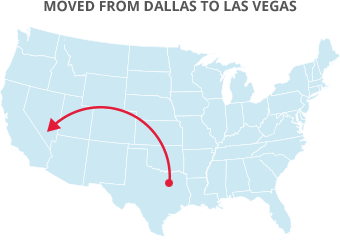

By Julie DeLong, A-1 Freeman Moving Group
 Moving to Dallas in the winter could be a one of a kind adventure in case this is your first time, you will want to be well prepared for at least a handful of cold-weather predicaments. Combined with the typical obstacles of making sure you have a clean driveway and sidewalks along with turning the heater up prior to when the moving truck shows up, you may also realize that your new residence is less thermally insulated compared to the house you have moved from.
Moving to Dallas in the winter could be a one of a kind adventure in case this is your first time, you will want to be well prepared for at least a handful of cold-weather predicaments. Combined with the typical obstacles of making sure you have a clean driveway and sidewalks along with turning the heater up prior to when the moving truck shows up, you may also realize that your new residence is less thermally insulated compared to the house you have moved from.Insulation is something which is exceptionally challenging to check when selecting and moving to a new home in Dallas, no matter if you're leasing or purchasing. The pictures online simply don't show you exactly how toasty the spaces tend to be, and open houses are usually arranged to ensure the home is already warm when prospective new homeowners come in. You might not recognize until the initial few nights in the new house that this place contains cold breezes, freezing floors, or merely doesn't maintain heat the way you anticipate.
On the plus side, this is a situation homeowners and tenants have actually been experiencing for centuries and there are several uncomplicated remedies for a house that tends to be chilly in the winter months. Today, we're here to aid by explaining the simplest methods to insulate your property, increase the efficiency of your heating system, and revel in a comfortable wintertime after moving into your new home in Dallas.
Heavy Thermal Draperies
Windows are the number one cause of cold drafts in a home. New double-paned storm windows are fantastic for keeping the winter weather out as well as the heat in, but anything else can cause the windows to become an unpleasant path for cold to enter your home. Single-pane windows merely exchange the cold instantly, and the area around them is going to be noticeably cooler. Older double-paned home windows can permit cold air to leak through as the insulating seal has broken.
The solution? Halt that cold air using thick thermal window treatments. Thick drapes of almost any style can help but expressly, thermal curtains are intended to avert cold air in its tracks and keep it from escaping the frigid window panes. Your best bet is either draperies which fit snugly inside the window frame or draperies that go all the way to the flooring.
Area Rugs and Bath Rugs
Hard floor surfaces are another cause of cold in a new home and are certainly noticeable when you're still laying out your home furniture. Stone, concrete floors, in addition to tile floor coverings permits cold air to shift through them from the frosty soil underneath, setting up a undeniably cooling sensation beneath bare and sock-covered feet. Wood floors are a little better for insulation, although freezing drafts under the doors could still sweep through the home causing freezing toes throughout.
The solution to nippy floor coverings and floor-level breezes is area rugs. Especially for spaces floored with tile and stone, an area rug will add a fluffy layer of padding that will avert chilly air from ascending out of the floor whilst keeping your toes comfortable as you move throughout the area. Thick bath mats deliver an equivalent purpose in bathrooms and you can make use of utility area rugs that are straightforward to clean for cold kitchen floors and out of doors decks.
Draft Stoppers
Cold breezes under doors can be a hassle regardless of what kind of flooring surfaces you have if the doors are high enough up. This could be extremely bothersome when breezes move between your entrance hallway where chilly air gets in directly into the remaining portion of the residence. The solution to door drafts can be long sock-shaped objects often called draft stoppers. You can easily create your own with a bit of DIY stitching and a variety of old socks, or you may buy them at the retail store for a very minimal price. These essentially build a fluffy buffer below the door that swings conveniently with the door however stops frosty breezes from blowing through the house.
Open Each of the Vents
If a couple of areas are notably nippy and you cannot understand why, check out the air vents. There is a possibility that the previous occupant might have closed certain vents in the house, preventing central heating from entering into these spaces. Make sure all your vents in the house are open to supply even heat or, if there is a room you do not use, close that vent and utilize a draft stopper to conserve a little bit of HVAC money on heating that space.
Space Heaters
Finally, certain dwellings just have an uneven heating profile. If a couple areas simply do not get warm enough through the night or through the day, consider selective usage of a space heater. Space heaters are excellent and often very potent little units which can warm a particular room area. They'll ensure that your children don't shiver during the night, balance out cold window drafts, or they may be utilized to typically raise the temperature of your abode by putting them in key areas and doorways. It is important to never leave a space heater on if you leave the house or unwatched overnight with no automatic thermostat/timed shutoff function and make sure to adhere to all manufacturer guidelines for safe use.
---
From time to time, after moving to a new home in Dallas, you find that it is colder than anticipated. Luckily, using these basic options you can quickly improve the insulation and draft resistance of your house and enjoy a cozy winter in your new place in Dallas.
Request a free quote

